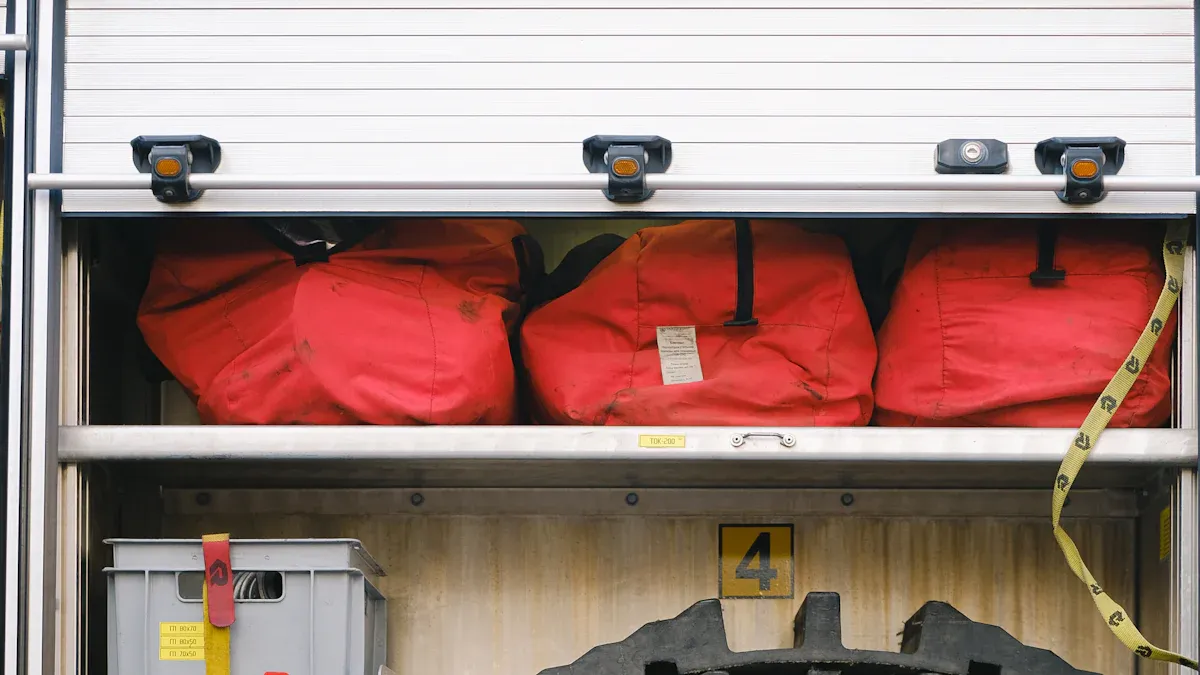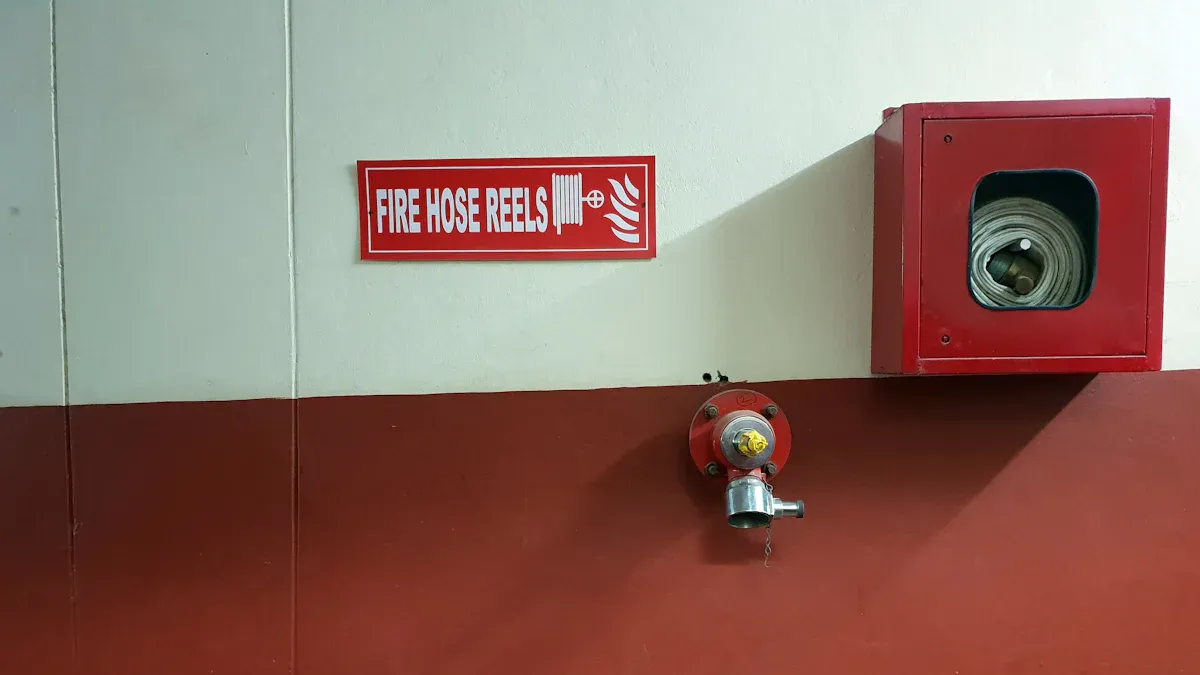
Regular hose reel cabinet maintenance keeps equipment dependable and safe. Fire Hose Reel&Cabinet users see fewer breakdowns and safer workplaces. A clean Fire Extinguisher Cabinet reduces risk during emergencies. Dry Powder Fire Extinguisher and Fire Hose Reel checks help prevent costly repairs. Proper care extends the life of every component.
Key Takeaways
- Regular maintenance keeps hose reel cabinets safe, reliable, and ready for emergencies, preventing costly repairs and equipment failure.
- Follow a clear schedule for cleaning, inspecting, lubricating, and storing hose reels to extend their lifespan and meet safety standards.
- Train maintenance staff properly to ensure effective care, reduce risks, and maintain compliance with fire safety regulations.
Why Hose Reel Cabinet Maintenance Matters
Risks of Neglecting Hose Reel Cabinet Maintenance
Neglecting hose reel cabinet maintenance can lead to serious problems. Dust and debris may build up inside the cabinet, making it hard to access the hose during an emergency. Corrosion can weaken metal parts, causing leaks or even failure when water is needed most. Without regular checks, hoses may develop cracks or kinks, which reduce water flow and make firefighting less effective. Over time, missing or broken components can go unnoticed, putting lives and property at risk. Insurance claims may be denied if the equipment does not meet safety standards.
Tip: Regular inspections help spot small issues before they become big problems.
Benefits of Regular Hose Reel Cabinet Maintenance
Organizations that follow a maintenance program for hose reel cabinets see many advantages:
- Fire hoses stay in good condition and last longer.
- Cabinets remain organized and easy to use in emergencies.
- Inspections and flushing remove debris, following NFPA 1962 guidelines.
- Inspection records support compliance and help plan for replacements.
- Well-maintained hoses work reliably, protecting people and property.
- Meeting fire safety rules can lower insurance costs.
- A strong safety record builds trust with clients and partners.
ISO 11601 sets important standards for hose reel cabinets, making sure they work well and are easy to use. UL standards and NFPA codes, such as NFPA 25, require regular inspection, testing, and maintenance. These certifications ensure that hose reel cabinets meet strict safety requirements and pass regulatory checks.
Essential Hose Reel Cabinet Maintenance Practices

Hose Reel Cabinet Cleaning Steps
Routine cleaning keeps the hose reel cabinet ready for emergencies. Start by removing dust and debris from the cabinet exterior and interior. Use a soft brush or cloth to wipe down surfaces, paying attention to corners and hinges. Clean the glass panel with a non-abrasive cleaner to maintain visibility. Remove any cobwebs or insects that may block access. For stubborn grime, use mild soap and water, then dry thoroughly to prevent moisture buildup. Always check for signs of mold or mildew, especially in humid environments. Yuyao World Fire Fighting Equipment Factory recommends following manufacturer guidelines for cleaning agents to avoid damaging cabinet finishes.
Tip: Clean the hose and nozzle as well, ensuring no dirt or residue remains that could block water flow.
Hose Reel Cabinet Inspection Checklist
A thorough inspection ensures the hose reel cabinet functions correctly during emergencies. Safety standards recommend the following checklist:
- Accessibility: Confirm the hose reel is unobstructed and easy to reach.
- Signage: Check that location signs are visible and operating instructions are legible.
- Cabinet/Housing: Inspect for damage, corrosion, secure mounting, and smooth door operation.
- Glass Panel: Ensure integrity and cleanliness.
- Hose Reel Assembly: Test reel rotation, swing arm movement, and brake mechanism.
- Hose Condition: Look for kinks, cracks, mildew, leaks, or abrasions. Verify the hose is properly racked and service date is current.
- Nozzle & Couplings: Confirm nozzle presence, cleanliness, tight couplings, and good gasket condition.
- Water Supply & Valve: Check for leaks, smooth valve operation, and normal pressure readings.
- Functional Test: Unwind the hose, verify water flow and pressure, and test nozzle operation.
- Pressure Testing: Every five years, conduct a service test to check hose integrity under pressure.
- Associated Equipment: Ensure hydrant wrench, spare nozzle, repair kit, and adapters are present and in good condition.
- Inspection Records: Attach service tags and document all findings.
Note: Monthly visual inspections and annual service tests help maintain compliance and readiness.
Lubrication for Hose Reel Cabinet Components
Proper lubrication prevents wear and corrosion in moving parts. Use specialized lubricants like ReelX or ReelX Grease, which protect metals with polar bonding technology and resist moisture. These products work well on steel, stainless steel, aluminum, copper, brass, and bronze. Petroleum-based or synthetic oils also suit hose reel components, especially in industrial settings. Apply lubricant to reel bearings, swing arms, and brake mechanisms. Lubricate after cleaning and during scheduled maintenance to ensure smooth operation. Yuyao World Fire Fighting Equipment Factory advises checking manufacturer recommendations for compatible lubricants.
Proper Hose Reel Cabinet Storage Techniques
Correct storage extends the lifespan of hoses and cabinets. Use lockable, ventilated cabinets to prevent moisture buildup and shield hoses from environmental exposure. Maintain storage temperatures between 10°C and 24°C, and control humidity to avoid mold or corrosion. Store hoses away from direct sunlight, ozone, and chemicals. Clean and dry hoses before storage, inspecting for cracks, bulges, or leaks. Use racks or reels to prevent kinks and tangles. Label hoses for easy identification and maintenance tracking. Regularly inspect stored hoses and replace any that show signs of degradation.
Callout: Improper storage can cause cracks, leaks, and kinks, making hoses unusable during emergencies. Always store hoses in cool, dry, and accessible locations.
Preventive Maintenance Schedule for Hose Reel Cabinets
A structured maintenance schedule reduces failure rates and ensures operational readiness. Manufacturers recommend the following routine:
- Inspect hose reel cabinets every 90 days or as required by local authorities.
- Check cabinet integrity, accessibility, and operational status.
- Verify legibility of instructions, cabinet condition, and ease of opening.
- Ensure hose rack swings out 90°, safety seals are intact, and no visible damage exists.
- Confirm hose is neatly folded, properly connected, and free from breaks or holes.
- Inspect nozzle, warning labels, and tags for presence and condition.
- Ensure valves, hose nozzles, and fire extinguishers are accessible.
- Perform annual inspections of the fire hose and steel rack.
- Replace or repair damaged couplers, sections, or mounting clips.
- Maintenance should be performed by qualified personnel.
Following this schedule, as practiced by Yuyao World Fire Fighting Equipment Factory, helps detect wear, corrosion, and operational issues early. Adherence to preventive maintenance schedules, as outlined in standards like NFPA 25, directly lowers failure rates and preserves system readiness.
Troubleshooting Common Hose Reel Cabinet Issues
Common problems include leaks, blockages, and hose fatigue. Address these issues with the following steps:
- Fix leaks at joints or couplings by replacing worn washers or using plumber’s tape.
- Repair hose body leaks by cutting out damaged sections and reconnecting with repair couplings.
- Replace cracked or aging hoses with UV-resistant models.
- Remove blockages by flushing hoses and cleaning nozzles.
- Adjust spring tension or replace brake shoes if the reel rewinds too fast.
- Untangle hoses and remove debris to resolve retraction issues.
- Lubricate moving parts to ensure smooth operation.
- Store hoses properly to prevent future damage.
- Seek professional help for severe or complex repairs.
Tip: Regular cleaning and inspection prevent most common issues and keep the hose reel cabinet ready for emergencies.
Training and Best Practices for Hose Reel Cabinet Maintenance
Proper training ensures maintenance staff follow best practices and safety standards. Personnel should understand cleaning, inspection, lubrication, and storage procedures. Training should cover the use of inspection checklists, identification of wear or damage, and correct application of lubricants. Staff must know how to document inspections and repairs, maintain compliance with local regulations, and respond to emergencies. Yuyao World Fire Fighting Equipment Factory provides training resources and support to help organizations maintain high safety standards. Ongoing education and refresher courses keep teams updated on new technologies and regulatory changes.
Note: Well-trained staff reduce risks, extend equipment lifespan, and ensure reliable performance of every hose reel cabinet.
Consistent Hose Reel Cabinet maintenance increases equipment lifespan and keeps performance reliable. Manufacturer guidelines help users select strong, corrosion-resistant cabinets with smart layouts and clear panels for easy checks. Following a structured schedule and proper training reduces risks, lowers costs, and maximizes safety for every facility.
FAQ
How often should a hose reel cabinet undergo inspection?
Experts recommend inspecting hose reel cabinets every three months. Annual professional servicing ensures all components work correctly and meet safety standards.
What signs indicate a hose reel needs replacement?
- Cracks in the hose
- Leaks at couplings
- Rust on metal parts
Any of these signs mean replacement is necessary.
Can anyone perform hose reel cabinet maintenance?
Only trained personnel should maintain hose reel cabinets. Proper training ensures safety and compliance with industry standards.
Post time: Jul-10-2025

